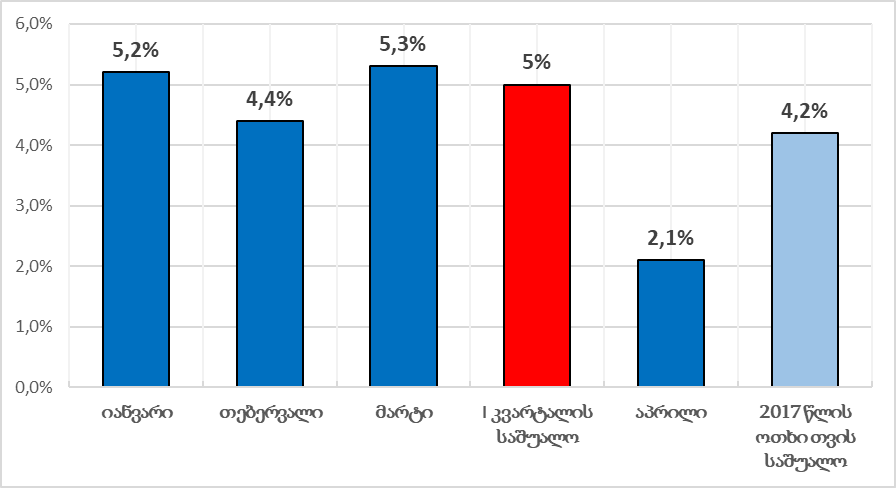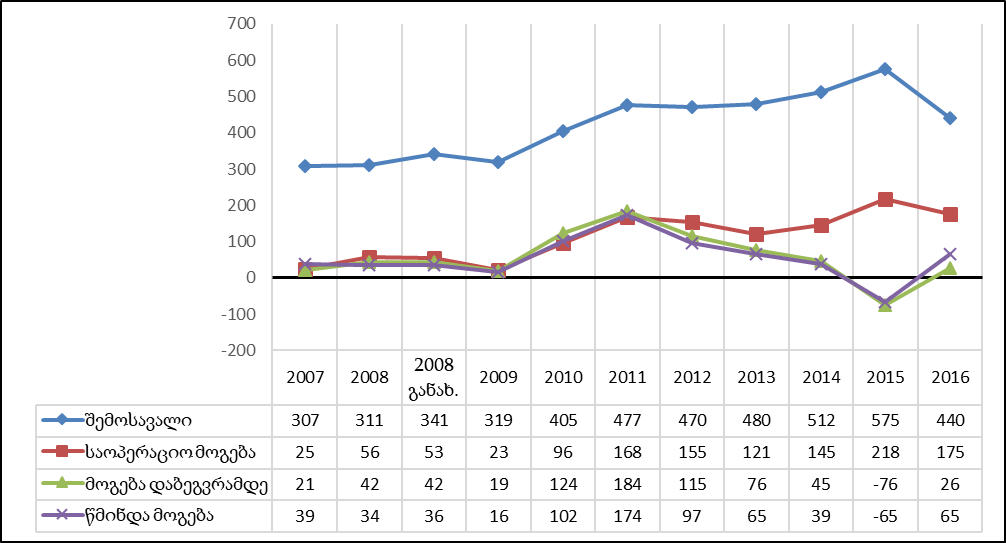On 8 June 2017, at the session of the Parliament of Georgia, a member of the Movement for Freedom – European Georgia, Irakli Abesadze, stated: “In 2007-2008, railway cargo turnover was approximately 23 million tonnes, whilst in 2012 it was decreased to 20 million tonnes, in 2015 it dropped further to 14 million tonnes and for this year, planned annual amount is 11 million tonnes. Correspondingly, railway profits were also reduced. If in the tree year period, 2009-2012, railway profit reached USD 227 million, in 2013-2016 it was three times less and constituted USD 87 million.”
FactCheck took interest in the accuracy of the statement.
For the last 25 years, the largest turnover of cargo transported by Georgian Railway was registered in 2006, when the figure was 22.6 million tonnes. As the graphic bellow illustrates, in the period of 2005-2012, cargo turnover has been constantly exceeding 20 million tonnes and the only exceptions are post-crisis 2009 year with 17.1 million tonnes of transported cargo and 2010, when the cargo turnover was 19.9 million tonnes.
Graph 1: Railway Cargo Turnover
 Source: Georgian Railway
In 2013, railway cargo turnover dropped to 18.2 million tonnes, trend of decline has been kept in place and in 2016, volume of cargo transported by railway constituted only 11.9 million tonnes. The figure of the trade turnover of the first four months of 2017 is decreased as compared to the same period of the previous year and is only 3.6 million tonnes. FactCheck was unable to find information about the planned trade turnover of 2017.
In regard to financial figures of the Georgian Railway, Graph 2 illustrates those stats. Irakli Abesadze’s figures are given in USD, whilst financial indicators in the Georgian Railway’s documents are given in GEL. Therefore, considering the significant fluctuation of GEL to USD exchange rate during the period of analysis, it is practically impossible to verify Irakli Abesadze’s figures vis-à-vis official data. On the other hand, several different financial indicators (operating profit, profit before tax, net profit) can be used to measure the volume of profit. Hence, evaluation of trend of changes of financial figures in the given part is a better indicator than comparison of absolute numbers.
Graph 2: Georgian Railway’s Financial Figures (GEL Million)
Source: Georgian Railway
In 2013, railway cargo turnover dropped to 18.2 million tonnes, trend of decline has been kept in place and in 2016, volume of cargo transported by railway constituted only 11.9 million tonnes. The figure of the trade turnover of the first four months of 2017 is decreased as compared to the same period of the previous year and is only 3.6 million tonnes. FactCheck was unable to find information about the planned trade turnover of 2017.
In regard to financial figures of the Georgian Railway, Graph 2 illustrates those stats. Irakli Abesadze’s figures are given in USD, whilst financial indicators in the Georgian Railway’s documents are given in GEL. Therefore, considering the significant fluctuation of GEL to USD exchange rate during the period of analysis, it is practically impossible to verify Irakli Abesadze’s figures vis-à-vis official data. On the other hand, several different financial indicators (operating profit, profit before tax, net profit) can be used to measure the volume of profit. Hence, evaluation of trend of changes of financial figures in the given part is a better indicator than comparison of absolute numbers.
Graph 2: Georgian Railway’s Financial Figures (GEL Million)
 Source: Georgian Railway
As illustrated by the graph, in the period of 2007-2015, with post-crisis 2009 being the only exception, Georgian Railway’s profits have a growth trend and decline of profits is registered only in 2016. At the first glance, this is illogical in light of the significantly reduced cargo turnover. However, if we take into account the fact that tariffs of cargo shipment are denominated in foreign currency, it will be obvious that a principal factor behind the growth of GEL denominated profits is depreciation of GEL exchange rate instead of any real positive development. This assessment is further corroborated by explicit decline trend of profitability. In 2015, Georgian Railway’s net profit became negative (loss) for the first time since 2007. In terms of absolute figures, total net profit in 2013-2016 reached GEL 104 million, which is 3.7 times less (GEL 389 million) as compared to the total figure of 2009-2012. Of note is that the comparison of similar periods illustrate that in 2013-2016, operating profit has increased 1.5 times. However, as we have already mentioned, since the tariff is denominated in foreign currency, the aforementioned growth is largely stipulated by GEL depreciation.
Conclusion
Georgian Railway’s cargo turnover reached its peak 22.6 million tonnes in 2006 and average annual cargo turnover in 2007-2008 was 21.7 million tonnes. Since 2013, decline trend of cargo turnover has been obvious and according to 2016 data, Georgian Railway transported only 11.9 million tonnes of cargo. FactCheck could not find information about planned cargo shipment figures for 2017.
In light of decreased cargo turnover, GEL denominated total profits has been growing. The reason behind that is the depreciation of GEL, whilst tariffs are denominated in foreign currency. At the same time, figures of profits before tax and net profit are significantly decreased. In 2015, for the first time during the period of analysis, Georgian Railway’s net profit is negative (loss). According to the data of the first quarter of 2017, incomes are decreased by GEL 4 million as compared to the same period of the previous year and now constitute GEL 104 million.
Therefore, Irakli Abesadze’s statement is TRUE.
Source: Georgian Railway
As illustrated by the graph, in the period of 2007-2015, with post-crisis 2009 being the only exception, Georgian Railway’s profits have a growth trend and decline of profits is registered only in 2016. At the first glance, this is illogical in light of the significantly reduced cargo turnover. However, if we take into account the fact that tariffs of cargo shipment are denominated in foreign currency, it will be obvious that a principal factor behind the growth of GEL denominated profits is depreciation of GEL exchange rate instead of any real positive development. This assessment is further corroborated by explicit decline trend of profitability. In 2015, Georgian Railway’s net profit became negative (loss) for the first time since 2007. In terms of absolute figures, total net profit in 2013-2016 reached GEL 104 million, which is 3.7 times less (GEL 389 million) as compared to the total figure of 2009-2012. Of note is that the comparison of similar periods illustrate that in 2013-2016, operating profit has increased 1.5 times. However, as we have already mentioned, since the tariff is denominated in foreign currency, the aforementioned growth is largely stipulated by GEL depreciation.
Conclusion
Georgian Railway’s cargo turnover reached its peak 22.6 million tonnes in 2006 and average annual cargo turnover in 2007-2008 was 21.7 million tonnes. Since 2013, decline trend of cargo turnover has been obvious and according to 2016 data, Georgian Railway transported only 11.9 million tonnes of cargo. FactCheck could not find information about planned cargo shipment figures for 2017.
In light of decreased cargo turnover, GEL denominated total profits has been growing. The reason behind that is the depreciation of GEL, whilst tariffs are denominated in foreign currency. At the same time, figures of profits before tax and net profit are significantly decreased. In 2015, for the first time during the period of analysis, Georgian Railway’s net profit is negative (loss). According to the data of the first quarter of 2017, incomes are decreased by GEL 4 million as compared to the same period of the previous year and now constitute GEL 104 million.
Therefore, Irakli Abesadze’s statement is TRUE.
 Source: Georgian Railway
In 2013, railway cargo turnover dropped to 18.2 million tonnes, trend of decline has been kept in place and in 2016, volume of cargo transported by railway constituted only 11.9 million tonnes. The figure of the trade turnover of the first four months of 2017 is decreased as compared to the same period of the previous year and is only 3.6 million tonnes. FactCheck was unable to find information about the planned trade turnover of 2017.
In regard to financial figures of the Georgian Railway, Graph 2 illustrates those stats. Irakli Abesadze’s figures are given in USD, whilst financial indicators in the Georgian Railway’s documents are given in GEL. Therefore, considering the significant fluctuation of GEL to USD exchange rate during the period of analysis, it is practically impossible to verify Irakli Abesadze’s figures vis-à-vis official data. On the other hand, several different financial indicators (operating profit, profit before tax, net profit) can be used to measure the volume of profit. Hence, evaluation of trend of changes of financial figures in the given part is a better indicator than comparison of absolute numbers.
Graph 2: Georgian Railway’s Financial Figures (GEL Million)
Source: Georgian Railway
In 2013, railway cargo turnover dropped to 18.2 million tonnes, trend of decline has been kept in place and in 2016, volume of cargo transported by railway constituted only 11.9 million tonnes. The figure of the trade turnover of the first four months of 2017 is decreased as compared to the same period of the previous year and is only 3.6 million tonnes. FactCheck was unable to find information about the planned trade turnover of 2017.
In regard to financial figures of the Georgian Railway, Graph 2 illustrates those stats. Irakli Abesadze’s figures are given in USD, whilst financial indicators in the Georgian Railway’s documents are given in GEL. Therefore, considering the significant fluctuation of GEL to USD exchange rate during the period of analysis, it is practically impossible to verify Irakli Abesadze’s figures vis-à-vis official data. On the other hand, several different financial indicators (operating profit, profit before tax, net profit) can be used to measure the volume of profit. Hence, evaluation of trend of changes of financial figures in the given part is a better indicator than comparison of absolute numbers.
Graph 2: Georgian Railway’s Financial Figures (GEL Million)
 Source: Georgian Railway
As illustrated by the graph, in the period of 2007-2015, with post-crisis 2009 being the only exception, Georgian Railway’s profits have a growth trend and decline of profits is registered only in 2016. At the first glance, this is illogical in light of the significantly reduced cargo turnover. However, if we take into account the fact that tariffs of cargo shipment are denominated in foreign currency, it will be obvious that a principal factor behind the growth of GEL denominated profits is depreciation of GEL exchange rate instead of any real positive development. This assessment is further corroborated by explicit decline trend of profitability. In 2015, Georgian Railway’s net profit became negative (loss) for the first time since 2007. In terms of absolute figures, total net profit in 2013-2016 reached GEL 104 million, which is 3.7 times less (GEL 389 million) as compared to the total figure of 2009-2012. Of note is that the comparison of similar periods illustrate that in 2013-2016, operating profit has increased 1.5 times. However, as we have already mentioned, since the tariff is denominated in foreign currency, the aforementioned growth is largely stipulated by GEL depreciation.
Conclusion
Georgian Railway’s cargo turnover reached its peak 22.6 million tonnes in 2006 and average annual cargo turnover in 2007-2008 was 21.7 million tonnes. Since 2013, decline trend of cargo turnover has been obvious and according to 2016 data, Georgian Railway transported only 11.9 million tonnes of cargo. FactCheck could not find information about planned cargo shipment figures for 2017.
In light of decreased cargo turnover, GEL denominated total profits has been growing. The reason behind that is the depreciation of GEL, whilst tariffs are denominated in foreign currency. At the same time, figures of profits before tax and net profit are significantly decreased. In 2015, for the first time during the period of analysis, Georgian Railway’s net profit is negative (loss). According to the data of the first quarter of 2017, incomes are decreased by GEL 4 million as compared to the same period of the previous year and now constitute GEL 104 million.
Therefore, Irakli Abesadze’s statement is TRUE.
Source: Georgian Railway
As illustrated by the graph, in the period of 2007-2015, with post-crisis 2009 being the only exception, Georgian Railway’s profits have a growth trend and decline of profits is registered only in 2016. At the first glance, this is illogical in light of the significantly reduced cargo turnover. However, if we take into account the fact that tariffs of cargo shipment are denominated in foreign currency, it will be obvious that a principal factor behind the growth of GEL denominated profits is depreciation of GEL exchange rate instead of any real positive development. This assessment is further corroborated by explicit decline trend of profitability. In 2015, Georgian Railway’s net profit became negative (loss) for the first time since 2007. In terms of absolute figures, total net profit in 2013-2016 reached GEL 104 million, which is 3.7 times less (GEL 389 million) as compared to the total figure of 2009-2012. Of note is that the comparison of similar periods illustrate that in 2013-2016, operating profit has increased 1.5 times. However, as we have already mentioned, since the tariff is denominated in foreign currency, the aforementioned growth is largely stipulated by GEL depreciation.
Conclusion
Georgian Railway’s cargo turnover reached its peak 22.6 million tonnes in 2006 and average annual cargo turnover in 2007-2008 was 21.7 million tonnes. Since 2013, decline trend of cargo turnover has been obvious and according to 2016 data, Georgian Railway transported only 11.9 million tonnes of cargo. FactCheck could not find information about planned cargo shipment figures for 2017.
In light of decreased cargo turnover, GEL denominated total profits has been growing. The reason behind that is the depreciation of GEL, whilst tariffs are denominated in foreign currency. At the same time, figures of profits before tax and net profit are significantly decreased. In 2015, for the first time during the period of analysis, Georgian Railway’s net profit is negative (loss). According to the data of the first quarter of 2017, incomes are decreased by GEL 4 million as compared to the same period of the previous year and now constitute GEL 104 million.
Therefore, Irakli Abesadze’s statement is TRUE.
Tags:








